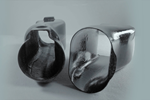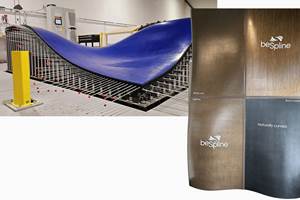UDRI opens RAAM lab to advance robotic femtosecond laser
RoboCLASP, an athermal ablation system initiated for preparing composites for bonded assembly, is being roboticized to advance U.S. Air Force needs.
A team of engineers at the University of Dayton Research Institute (UDRI, Ohio, U.S.), announce the development of an ultra-fast robotic laser system that proved so successful in its initial intended use in composites processing, that UDRI has now opened a new laboratory to exploit the technology’s potential in a variety of additional applications in advanced manufacturing.
The Rapid Applications of Advanced Manufacturing (RAAM) laboratory is located in the Dayton Composite Center in Kettering, Ohio. The laser technology it has been dedicated to, named RoboCLASP (“Composite Laser Ablation for Surface Preparation”), has been used to prepare composites for bonded assembly, offering a “significantly advanced alternative to current and traditional method of hand sanding polymer matrix composite materials,” according to Michael Pratt, advanced manufacturing engineer and RAAM team lead. Developed under U.S. Air Force funding with support from commercial aerospace partners, the system uses a “femtosecond” laser, which generates ultra-short, high-energy pulses of light to remove resin from composites without damage to the material.
“As far as we can find in our research, we are the first organization in the world to deploy and integrate a femtosecond laser into a portable and handheld system,” Pratt says, “and we are now the only organization in the U.S. that is actively developing a robotically integrated system for this
application.”
The process of hand sanding composites to prepare them for bonding is not only time- and labor-intensive, but it also requires the operator to wear a hazmat suit because the process generates hazardous waste in the form of plastic media.
“Another challenge is that some composite parts and materials are too delicate to be hand sanded because of the risk of damage to the part if the operator goes too deep,” Pratt explains. “Laser resin removal is safer, cleaner, faster and more affordable. The robotic femtosecond laser process — known as athermal ablation — significantly minimizes waste generation and is highly accurate in precisely removing only the resin, with zero risk of damage to the composite material.”
Unlike continuous wave lasers, which emit a steady beam of light that will ultimately burn a material, ultra-short pulse lasers emit powerful but very short bursts of light — short enough to be measured on the order of femtoseconds, or one quadrillionth of a second. Because each burst of light is so short in duration, there is no time for heat to be generated in the target material before it is broken down and easily removed by vacuum filtration.
“We have already identified many other areas where automated ultra-short pulse laser ablation will be transformational.”
UDRI’s first portable femtosecond laser system was developed in 2021 by its Laser Manufacturing Technology Development (LMTD) team, which is led by advanced manufacturing engineer Jared Speltz. It was later licensed to Albers Aerospace. The system at the time used a handheld laser, while this latest iteration is robotic.
“By automating the system, we can program it to perform highly complex coating removal tasks,” Pratt says. “The robot scans the material sample to be lased to create a 3D roadmap, and then automatically adjusts the laser to accommodate the material’s varying geometry, always keeping it in focus so that it ablates specifically what needs to be removed without damage to any other material.”
Adam Hicks, advanced laser manufacturing lead for the Digital Manufacturing and Supply Chain Branch of the Air Force Research Laboratory (AFRL) Materials & Manufacturing Directorate, says he anticipates RoboCLASP will be transitioned to other applications in manufacturing, with the potential for significant cost savings to the Air Force.
“RoboCLASP is the first of many applications we envision for advanced laser manufacturing within the Air Force,” Hicks says. “It was a reaction to a near-term manufacturing need for the Air Force to reduce the cost and time associated with manual sanding. Working with UDRI, we delivered transitional capability at a speed which I find truly staggering.
“While the initial customer for a robotically integrated laser manufacturing demonstration continues to be the CLASP team, we have already identified many other areas where automated ultra-short pulse laser ablation will be transformational,” Hicks continues. “Combined, I estimate that this technology has the promise to save the Department of Defense tens of millions of dollars in the next few years alone while providing a cleaner, faster, higher quality manufacturing process.”
Pratt says additional applications could include coatings and paint removal, 3D texturing for additive manufacturing and machining ceramic parts, which are typically difficult to machine. He also says the RAAM and LMTD teams are pursuing funding opportunities to expand the RAAM Lab and its capabilities in these areas, among others, in an effort to anticipate its customers’ future advanced manufacturing needs.
Related Content
Zünd, Loop Technology partner on FibreLine preforming system
Pairing Loop Technology’s automation with Zünd digital cutters provides faster cutting, less stray fibers, higher ply accuracy and more precise preforms for composite aerostructure manufacturing.
Read MoreOptimizing robotic winding of composite tanks and pipes
Pioneer in mandrel-based reinforced rubber and composite products, TANIQ offers TaniqWindPro software and robotic winding expertise for composite pressure vessels and more.
Read MorePlant tour: BeSpline/Addcomp, Sherbrooke, QC, Canada
Composites automation specialist increases access to next-gen technologies, including novel AFP systems and unique 3D parts using adaptive molds.
Read MoreModular, robotic cells enable high-rate RTM using any material format
Airborne’s automated ply placement systems at Airbus, GKN Aerospace and Teijin Automotive Technologies aim to maximize flexibility and intelligent automation.
Read MoreRead Next
ICOMAT opens first production facility, Factory 1
Two-phase opening in Gloucester, U.K., builds on iCOMAT’s comprehensive composites engineering service offerings for aerospace and automotive.
Read MoreVIDEO: AI, cameras and lasers for FOD detection
Virtek Vision demonstrates its Iris AI technology at CAMX 2024. It combines laser projection with machine learning software to detect foreign object debris during a composite layup.
Read MoreSpintech awarded two U.S. STTR program contracts
Spintech partners with UDRI, an eVTOL OEM and Aurora Flight Sciences to explore manufacturing methods and materials for optimized eVTOL aircraft components and production.
Read More


























